


VEGETABLE DRESSINGS
SALAD DRESSINGS
DASHI AND OTHER
SWEET SAUCES FOR SAVORY MEALS
SWEET SAUCES FOR DESSERTS
Of all the Japanese vegetable dressings, this one is the most well known and can be found on the menus of Japanese restaurants all over the world. Though I find it is often oversweetened to the point of being almost cloying. Also a common mistake is not grinding the seeds enough.
sesame-miso dressing MAKES ENOUGH FOR 2 CUPS (225 G) OF VEGETABLES
GOMA-AE
4 tablespoons unhulled sesame seeds
3 tablespoons brown rice miso
2 tablespoons rice vinegar
Toast the sesame seeds over medium-high heat in a dry frying pan for a minute or so until they are fragrant and start to pop. Grind the seeds in a suribachi (Japanese grinding bowl) or mortar until most of the seeds have broken down and are almost pastelike. Smash in the miso and blend in the rice vinegar until creamy.
RATIO: sesame : miso : vinegar—4 : 3 : 2
VARIATION: A few slivers of yuzu or Meyer lemon peel are also a nice addition.
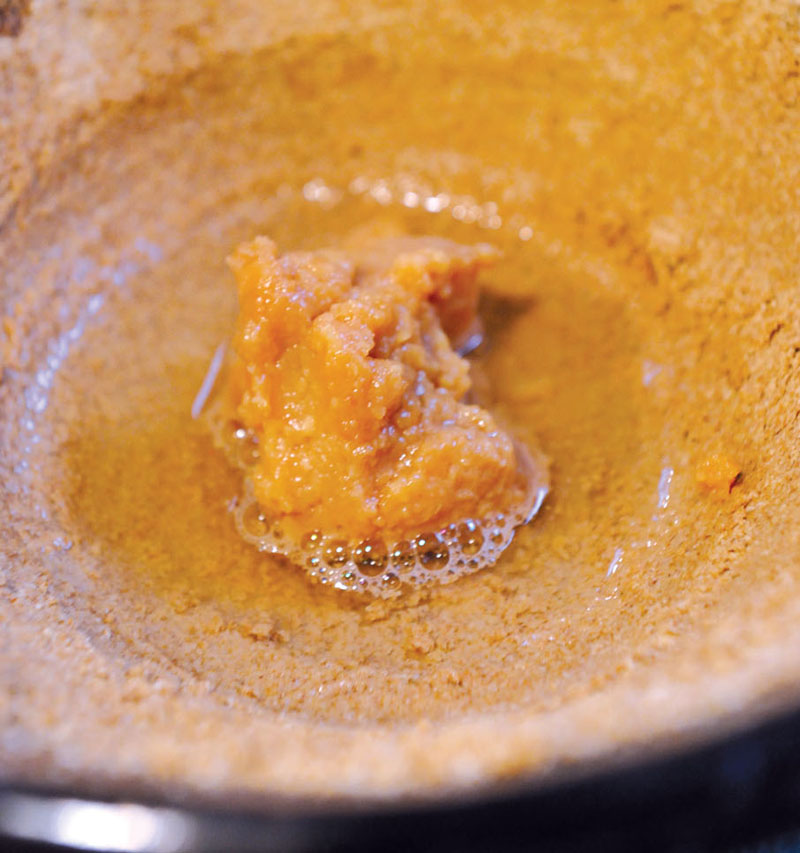
This creamy, subtly nutty treatment goes well with strong-flavored boiled, refreshed, and squeezed greens or boiled and refreshed vegetables. Many cooks add sugar to shira-ae, but that seems like a crazy idea because the sesame and tofu are naturally sweet—as are most of the vegetables you would pair with this. Good on mustard greens, rapini, komatsuna, mizuna, broccoli, or cauliflower.
tofu-miso dressing MAKES ENOUGH FOR A LARGE BUNCH OF GREENS
SHIRA-AE
1 (10.5-oz/300-g) block Japanese-style “cotton” tofu
2 tablespoons unhulled sesame seeds
2 tablespoons brown rice or barley miso
2 tablespoons rice vinegar or Warisu
¼ teaspoon sea salt
Zest of 1 small yuzu or ½ Meyer lemon, slivered (optional)
Place the tofu on a cutting board propped up on one end, angled into the kitchen sink for draining. Lay another chopping board or plate on top of the tofu to press out excess water for 1 hour.
Toast the sesame seeds over medium-high heat in a dry frying pan until they are fragrant and just starting to pop. Grind the sesame seeds in a suribachi (Japanese grinding bowl) or mortar until most of the seeds have broken down. Add the miso and vinegar to the mortar and blend.
Squeeze handfuls of tofu to express any lingering moisture and add to the dressing with the salt. Continue grinding to emulsify all the ingredients until creamy. Gently fold in the cooked greens or vegetables. Garnish with slivered yuzu peel, if you like.
RATIO: sesame : miso : vinegar—1 : 1 : 1
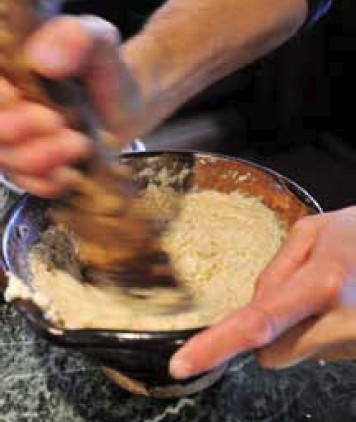
Walnuts (or pecans) substitute well for the traditional sesame in goma-ae, and they give the dressing a softer, perhaps fuller taste—sometimes a welcome change from the sesame-miso. This is exceptional made from black walnuts (onigurumi) if you can find them. Good with spinach or any other strong-flavored greens. Also nice with broccoli or cauliflower.
walnut-miso dressing MAKES ENOUGH FOR A LARGE BUNCH OF GREENS
KURUMI-AE
5 heaping tablespoons whole walnuts
2 tablespoons brown rice miso
1½ tablespoons rice vinegar
Grind 2 heaping tablespoons of walnuts in a suribachi (Japanese grinding bowl) or mortar until the nuts have been smashed a bit and resemble finely chopped nuts. Scrape into a bowl and reserve. Drop the remaining 3 tablespoons of walnuts into the grinding bowl and smash well until the oil has exuded from the walnuts and a rough paste has formed. Mash in the miso and rice vinegar and blend until creamy. Toss boiled, refreshed, squeezed greens or parboiled vegetables into the walnut-miso dressing with the reserved roughly crushed walnuts.
RATIO: walnuts : miso : vinegar—10 : 4 : 3 (about)
VARIATION: Substitute pecans for the walnuts.
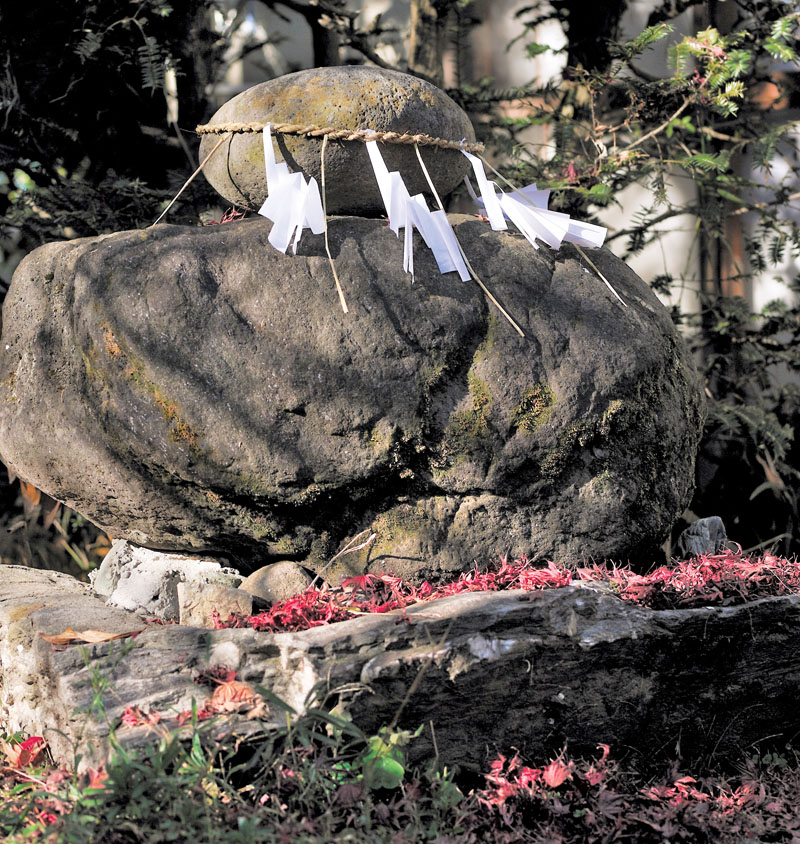
Somewhere along the way a few years ago, I fell completely in love with miso. Miso became a taste I craved. While this vinaigrette may never replace artisanal olive oil and homemade red wine vinegar, this miso-based dressing is good on just about anything. I particularly like it on peppery greens such as mizuna and mountain mitsuba; julienned vegetables such as celery, carrots, daikon, or turnips; blanched and refreshed green beans or pea pods (snow or snap); or even sliced new onions (though you may want to soak the onion threads a few minutes in cold water to remove some of their raw hotness). It is also good on chicken or crab salads.
miso vinaigrette MAKES ENOUGH FOR A MEDIUM-SIZED SALAD
MISO VINEGURETTO
1 tablespoon organic miso
1 tablespoon organic rice vinegar
2 tablespoons organic rapeseed oil
Muddle the miso with the vinegar and whisk in the oil. Keeps for several weeks or more, jarred, in the refrigerator.
RATIO: miso : rice vinegar : rapeseed oil—1 : 1 : 2

One of the first Japanese salad dressings I made, and for years it was the go-to substitute in our house for the classic olive oil and red wine vinegar dressing. In those days I used dark sesame oil and hot pepper oil (rayu), but am less inclined toward such heavy flavors these days because of my new love, the oh, so elegant organic rapeseed oil I buy from my pal at Matsuda Mayonnaise. Good on leafy greens such as lettuce, mizuna, or mibuna.
soy sauce vinaigrette MAKES ENOUGH FOR A MEDIUM-SIZED SALAD
SHOYU VINEGURETTO
1 tablespoon soy sauce
1 tablespoon rice vinegar
2 tablespoons rapeseed oil
Whisk the soy sauce and vinegar together in a small bowl before drizzle-whisking in the rapeseed oil to emulsify. Take care to rewhisk if you do not dress the salad immediately after making the vinaigrette.
Spoon enough well-emulsified vinaigrette on the salad to film the leaves and gently toss with light hands. The leaves should not be drippy, nor should there be any dressing pooled up in the bottom of the bowl after serving (if so, you have overdressed the salad). Save any extra dressing in a jar in the refrigerator. Keeps for several weeks or more.
RATIO: soy sauce : rice vinegar : rapeseed oil—1 : 1 : 2
VARIATION: Also excellent with a tablespoon of roughly ground toasted sesame seeds.
Miso and sesame are sort of a match made in heaven, especially if you add a little vinegar to cut their richness. Good on poached chicken salad.
sesame-miso vinaigrette MAKES ENOUGH FOR 1 MAIN-DISH SALAD
GOMA MISO VINEGURETTO
2 tablespoons unhulled sesame seeds
1 tablespoon brown rice miso
2 tablespoons rice vinegar
4 tablespoons rapeseed oil
Measure the sesame seeds into a small frying pan and roast over medium-high heat while lifting and shaking the pan to avoid burning the seeds. (They burn easily!) When the seeds start to pop, remove from the heat.
Slide the seeds into a Japanese grinding bowl (suribachi) or mortar and grind roughly (reserve a teaspoon or so of the smashed seeds to sprinkle on the salad after dressing). Mash in the miso to form a thick paste and add the vinegar to lighten (and brighten) the miso-sesame mixture. Whisk in the rapeseed oil slowly until emulsified. (Be sure to whisk again right before dressing your salad.)
Strew the dressed salad with the reserved roughly ground seeds.
RATIO: sesame : miso : rice vinegar : rapeseed oil—2 : 1 : 2 : 4
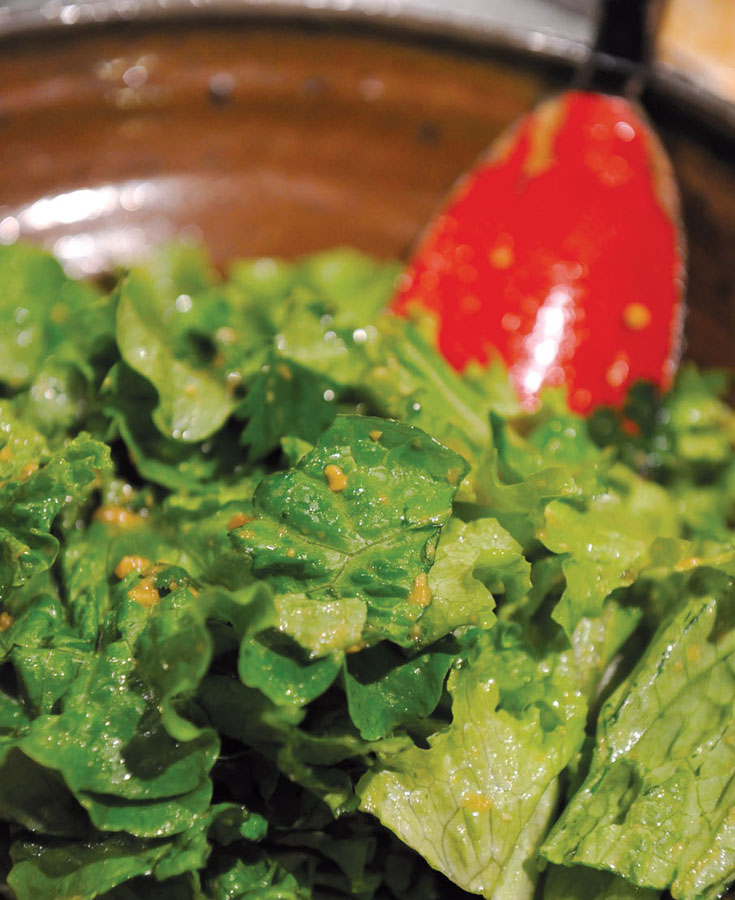
We have access to incredible citrus—one of the few organic fruits readily available in Japan. I use this citrus vinaigrette when I’m looking for an ultrafresh taste on my salad, and it is especially good with lettuce salads tossed with fresh crabmeat or small boiled and chilled Gulf shrimp. In that case, I would not presalt the lettuce leaves, just add some sea salt to taste when you dress the salad. Good with raw carrots, turnips, daikon, or napa cabbage and a bit of aromatics such as slivered green onion or tops from the salad vegetable to liven up the delicate dressing.
citrus vinaigrette MAKES ENOUGH FOR 1 MEDIUM-SIZED SALAD
KANKITSU VINEGURETTO
½ teaspoon fine sea salt
2 tablespoons mild citrus juice (yuzu, Seville orange, Meyer lemon)
2 tablespoons rapeseed oil
Sprinkle the sea salt onto julienned vegetables such as carrot, daikon, cabbage, or turnip (but don’t mix the varieties) and gently distribute with your hands.
Measure the citrus juice into a small bowl and whisk in the oil. Pour over the julienned vegetables and toss once or twice. Add a small amount of slivered green onion, vegetable tops, or whole aromatic herb leaves such as mitsuba to give a slight bite for balance. Toss quickly but lightly and serve.
RATIO: mild citrus (yuzu, Meyer lemon, grapefruit) : rapeseed oil—1 : 1
I love leeks vinaigrette and often make it at Christmastime. Japanese negi are exceptionally tender, so one night I thought of making this miso-mustard dressing instead of the classic mustard vinaigrette. It reminded me a bit of negi nuta, a vinegary miso dish we have occasionally at our friend Kanchan’s restaurant, Soba Ro. Good on winter lettuce salads or julienned carrot, turnip, or daikon salads.
miso-mustard vinaigrette MAKES ENOUGH FOR A MEDIUM-SIZED SALAD
KARASHI-MISO
3 tablespoons brown rice miso
3 tablespoons rice vinegar
1 tablespoon hot Dijon mustard (preferably Edmond Fallot)
Muddle the miso, rice vinegar, and Dijon mustard in a mortar or whisk in a small bowl. Keeps for a couple of weeks chilled in the fridge.
RATIO: miso : vinegar : mustard—3 : 3 : 1
Dashi is probably the most important building block in Japanese cooking. Many chefs (especially those from Kyoto) wax poetic about the special methods they employ to draw out the natural umami of the konbu and katsuobushi when making dashi. Even the water must come from the Kyoto area. Our dashi is a bit more straightforward and quite tasty, despite our more laissez-faire attitude and lack of Kyoto water. We use well water from our family well, and it works just fine. I’m sure the water wherever you live will work just as well. The important thing to remember here is that dashi—or for that matter any food—should not become an obsessive chore. If you start with great ingredients, your food will taste good.
dashi MAKES ABOUT 1⅓ CUPS (300 CC)
1 (6-inch/15-cm) length of konbu
Handful of dried bonito shavings (katsuobushi)
Place the konbu in a medium saucepan containing 2 cups (500 cc) of cold water. Bring almost to a boil (you will see minute bubbles form on the edges of the konbu) and remove the konbu. Throw in the dried bonito shavings and simmer friskily, but not crazily, for 8 minutes. Remove from the heat and let stand 8 minutes. Set a small fine-mesh strainer over a 1-quart (1-liter) measuring cup and pour the dashi through the strainer to remove the dried bonito shavings. You should have 1¼ cups (300 cc) dashi. If you do not, add water (pouring through the strainer holding the strained katsuobushi) to make the amount of liquid needed. Use within a day or so, if kept chilled in the fridge.
Warisu is a good alternative to straight rice vinegar when you want a softer vinegar flavor, such as when you are making Sesame-Miso Dressing. It is also nice on mild salads since there is a hint of katsubushi and konbu that gives the dressing a certain element of complexity. Make warisu when you have leftover dashi from making another recipe such as miso soup or ohitashi.
dashi vinegar MAKES 1⅓ CUP (300 CC)
WARISU
⅔ cup (150 cc) Dashi (above)
⅔ cup (150 cc) rice vinegar
Mix the dashi and rice vinegar together and pour into a well-labeled bottle or jar. Keeps for a couple of months refrigerated.
I first tasted tosajoyu at Kozushi, a phenomenal sushi shop that I came upon by sheer chance (or was it fate?) in the first few weeks after I had arrived in Japan. The master would always serve his sashimi with tosajoyu, then change out the small saucers for a lighter soy sauce when I moved on to the sushi. Tadaaki’s tosajoyu contains nothing more than excellent local soy sauce and katsuobushi, though other cooks may add sake, mirin, or even konbu. Use for dipping sashimi or drizzling on tofu.
katsuobushi-infused soy sauce MAKES ABOUT 1⅔ CUPS (400 CC)
TOSAJOYU
2 cups (500 cc) soy sauce
1 large handful of katsuobushi (hanakatsuo)
Bring the soy sauce and katsuobushi to a simmer over medium-low heat and cook at a gentle simmer for 10 minutes. Remove from the heat and let cool for about 8 to 10 minutes, or until you can comfortably insert your finger into the liquid. Strain and store for up to a year in the fridge.
Ponzu is one sauce I see completely bastardized all over the Internet and in Japanese cookbooks. Traditionally it was made from the juice of daidai (a bitter orange similar to Seville orange), not yuzu or vinegar (as many recipes say). Ponzu also usually has some dashi splashed in, but farmers most likely skip that unless they happen to have some handy. Farmers also like a strong salty flavor, since they work hard in the fields before sitting down to dinner. Good with most nabe such as Kelp-Wicked Red Snapper Shabu-Shabu, Monkfish Nabe with Mizuna, and (beef) Shabu-Shabu.
country-style ponzu MAKES 1 CUP (250 CC)
INAKA PONZU
½ cup (125 cc) soy sauce
½ cup (125 cc) bitter orange juice, yuzu juice, or ½ lemon–½ tangerine juice
Chopped chives (optional)
Mix the soy sauce and bitter orange juice (daidai) in a small bowl. Sprinkle in some chopped chives, if you like. Use within a day or so, but store in the fridge.
RATIO: soy sauce : citrus juice—1 : 1
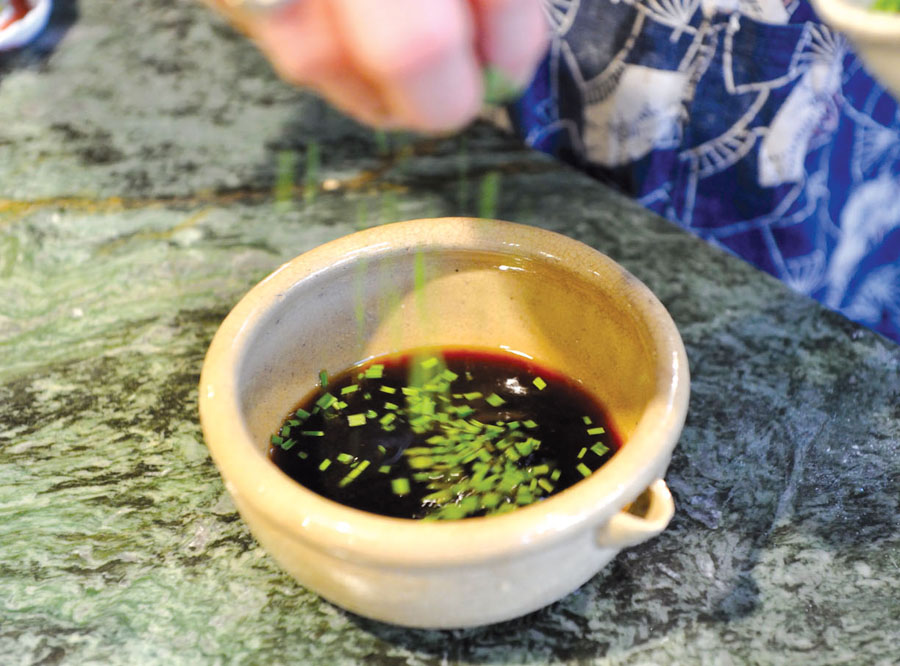
Kaeshi is an ingenious concoction that flavors dashi when making dipping sauces for noodles and tempura, or a hot broth for a noodle soup. While not the farm kitchen method, I was beguiled with how kaeshi relates to the dashi as a building block and could not leave it out of the book. Andrew, who works at our friend’s soba restaurants, was kind enough to walk me through the process (and approve of the results).
kaeshi MAKES ABOUT 2⅔ CUPS (600 CC)
1⅛ cup (125 g) organic sugar
2 cups (500 cc) organic soy sauce
Bring hon mirin to a simmer over high heat and cook, stirring constantly, until you no longer smell alcohol (3 to 5 minutes). Stir in the sugar and continue cooking (and stirring) until the sugar granules have dissolved. Add the soy sauce and watch as the kaeshi heats up and comes almost to a boil. You will see tiny bubbles form on the perimeter—remove the pan from the heat as soon as the entire surface of the kaeshi becomes a creamy tan from minute bubbles. Store for up to a year in the fridge.
RATIO: soy sauce : mirin : sugar—4 cc : 1 cc : 1 g
This “sauce” (which is more like a soup) can be served hot or cold, depending on the season. Good for dunking udon, soba, and somen noodles.
noodle dipping sauce MAKES ABOUT 1⅔ CUPS (400 CC)
MORI TSUYU
1⅓ cups (300 cc) Dashi
6 tablespoons Kaeshi (above)
Flavor the dashi with the kaeshi and use at room temperature, cold, or slightly warm, depending on your mood or the season.
RATIO: dashi : kaeshi—3.3 : 1
Kake tsuyu is a light, slightly sweet broth in which you serve a bowl of steaming noodles. Simmer some slivered negi and thinly sliced root vegetables such as turnips and carrots with roughly chopped chicken or duck meat, if desired. Plunk just-cooked (refreshed) noodles in the broth for a warm, comforting meal.
hot noodle broth MAKES ABOUT 1¼ CUPS (300 CC)
KAKE TSUYU
1⅓ cups (300 cc) Dashi
1 tablespoon Kaeshi
Mix dashi with kaeshi and use as is in tamago dofu; or bring to a gentle simmer in a small saucepan before serving as a noodle soup.
RATIO: dashi : kaeshi—10 : 1
In farming families you will more likely see tempura served with soy sauce, but for those who like a lighter, soupier dipping sauce, ten tsuyu is the traditional sauce that accompanies tempura in restaurants.
tempura dipping sauce MAKES ABOUT 2 CUPS (500 CC)
TEN TSUYU
1⅓ cups (300 cc) Dashi
2½ tablespoons Kaeshi
Combine the dashi and kaeshi in a small saucepan. Warm gently over low heat and ladle into small dipping bowls for each diner.
RATIO: dashi : kaeshi—4 : 1
Making mayonnaise successfully depends on fresh eggs, initial patience, and confidence in the process (experience doesn’t hurt). Use only the freshest farm eggs, otherwise it will be very difficult to emulsify (and risky for salmonella). You make Japanese-style mayonnaise by using rice vinegar instead of lemon and adding a little sugar or honey, though we usually do not sweeten ours. For Western-style mayonnaise, I use about 75 percent rapeseed oil and 25 percent good-quality extra-virgin olive oil (or more), depending on what I am making.
I buy organic Japanese rapeseed oil from Matsuda-san in 16-kg drums (big), but luckily my school assistants pour it into more conveniently sized jars for me.
japanese mayonnaise MAKES ABOUT 1 CUP (225 CC)
MAYONEIZU
1 very fresh raw egg yolk, at room temperature
1 teaspoon Dijon mustard (or ¼ teaspoon dried mustard)
1 teaspoon rice vinegar
About ¾ cup (180 to 200 cc) rapeseed oil, at room temperature
Fine sea salt
½ to 1 teaspoon sugar or honey (optional)
Put the egg yolk, mustard, and ½ teaspoon vinegar in a small, deep-sided bowl.
Whisk lightly to combine, then whisk in a fine stream of oil until the mayonnaise “takes.” If it does not emulsify soon, it never will. In this case, you will have to start over, whisking the broken egg yolk and oil mixture into a new egg yolk. Increase the total amount of oil as well.
Once the mayonnaise becomes a creamy sauce (not oily looking), you can add the oil a bit faster. At this point, I usually add a big glurp of oil, then whisk powerfully. Continue adding oil until the mixture is thick and holds its shape. Add sea salt to taste and the sugar or honey, if using. Taste for tartness and oil balance; add more oil or some of the remaining ½ teaspoon vinegar, if needed. The mayonnaise keeps for a few days in the refrigerator.
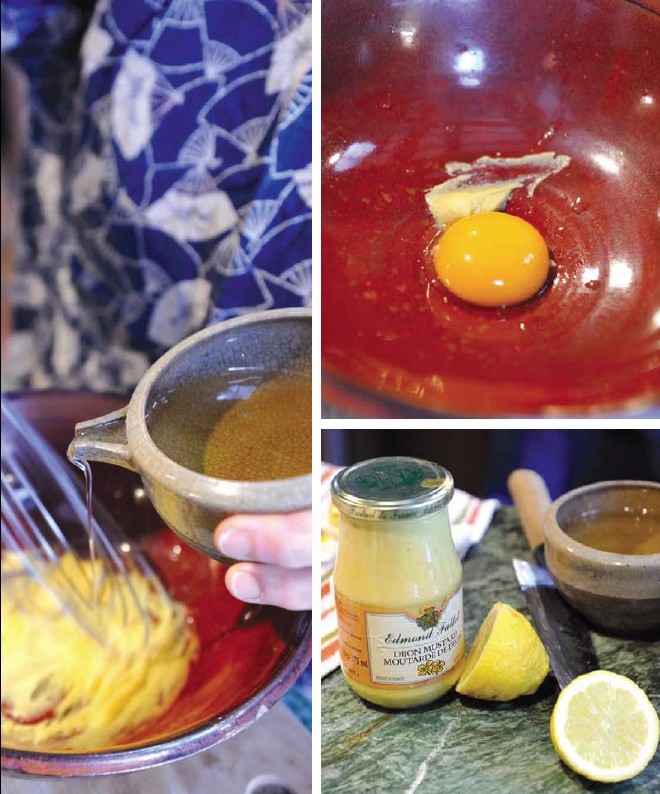
Mustard made from straight mustard powder by nature is going to be fiery hot and won’t have the creamy complexity of a good Dijon mustard, such as Edmond Fallot. You make the choice, however. Either way, you get the hotness needed for some of the rich Japanese dishes such as Simmered Kabocha and Konbu or Pork Belly Simmered in Okara.
japanese mustard MAKES 2 TABLESPOONS
KARASHI
2 tablespoons Oriental mustard powder
Measure the mustard powder into a small bowl and muddle in 1 teaspoon water until the paste is pliable but not runny. Let sit for 15 minutes, turned upside down on the counter, to mature and develop flavor. Use the same day or possibly the next if you fold it tightly into a small piece of plastic wrap and refrigerate.

In the fall of 2011 about twenty or so friends from Berkeley converged on Japan over the course of several weeks for a food and art installation project called OPENharvest. And during their visit here, they probably ate hundreds of bowls of ramen between them—sometimes more than once in one day. They were crazy for ramen. That ramen-fever rubbed off on me, so while I worked through book edits that fall, I too began to crave ramen and often snuck off for a solitary bowl at lunchtime. With ramen on the brain, I realized this book would not be complete without a recipe for rayu (red pepper oil) or yuzu kosho. Who did I turn to? Sylvan Mishima Brackett, my pal who runs Peko-Peko Japanese Catering, also one of the main organizers of the OPENharvest event, and a master of gyoza. Sylvan shot me an e-mail back right away with a list of ingredients he uses and the admonishment to “heat the chile and garlic slowly” since “heating kills their flavor.” I was on my own for proportions, but managed to hit it right on the first try. Making homemade rayu is so fundamentally simple, I am baffled why I have never made it before now.
chile-infused sesame oil MAKES ABOUT 1 CUP (240 CC)
RAYU
¾ cup (180 cc) best-quality dark sesame oil
¼ cup (60 cc) rapeseed or safflower oil
3 large cloves of strong-flavored winter garlic, cut into thick slivers
12 small dried red Japanese chile peppers, roughly crumbled
1 tablespoon unhulled sesame seeds
3 large pinches of katsuobushi flakes (hanakatsuo)
2 teaspoons sea salt
2 teaspoons best-quality hot paprika powder
Pour the oil into a small saucepan along with the garlic slivers and crumbled chile peppers. Heat slowly over low heat on a flame tamer, if you have one. Roast the sesame seeds over medium-high heat in a small dry skillet until the seeds start to pop.
Shake the pan and lift off of the heat a little to avoid burning the seeds. Reserve in a small bowl. Watch the oil closely as it warms.
As soon as teeny bubbles start to form around the garlic slivers and dried peppers, add the rest of the ingredients, and swirl the pan to distribute. Continue heating, but pick up the pan and swirl it anytime more bubbles appear. Do not let the oil simmer, as this will cause the rayu to become bitter. After about 5 minutes, turn off the heat, but let the rayu cool naturally on the flame tamer (or heat source). Continue to be vigilant about keeping the bubbles at bay by lifting up and swirling until they subside completely. Once the rayu has cooled sufficiently, with no danger of bubbles, cover and continue to cool naturally until it returns to room temperature.
Strain into a large glass measuring cup and divide between two small, dry jars. Scoop some of the strained aromatics into one of the jars to keep on extracting intensity—this style is used spooned over rice, or whatever, and is all the rage. It is called taberu rayu (“eating” rayu). Both keep for a year or more, refrigerated.
I have seen many yuzu kosho methods floating around the Internet, but, in my mind, this recipe (from Sylvan Mishima Brackett) is the most authentic. We are lucky to have a local person selling top-quality yuzu kosho at our local farm stands (¥350/$4.50 for a teensy jar holding 2 tablespoons), but homemade yuzu kosho will yield a brighter paste. You can use a mini-prep processor, but I recommend grinding by hand in a suribachi. It’s a little time consuming, but so much more satisfying. The fragrant yuzu skin can be replicated successfully, though not duplicated by Meyer lemon peel or another floral-skinned local lemon. Small Indian or Thai chiles can substitute for the Japanese chile peppers. Yuzu kosho is unforgettable in salt-flavored ramen and also gives a lively zip to Citrus Vinaigrette.
yuzu kosho MAKES ABOUT 5 TABLESPOONS
10 medium-sized yuzu or other fragrant lemon-like citrus
4 small or 2 medium-sized, fresh green Japanese chiles
2 tablespoons white sea salt
Pare off the outer zest of the yuzu with a very sharp knife. As the winter season wears on, the inside yuzu fruit tends to separate from the peel, so it may be difficult to avoid some of the white pith. Try your best, as the pith is bitter and will affect the taste of your yuzu kosho—keep the pith to the minimum possible. Lay the zest on a cutting board and chop briefly: once in each direction (you do not want to leave essential oils on the cutting board). Slide the zest into a suribachi (Japanese grinding bowl) or mini-prep food processor.
Slice off the tops of the chiles and roughly chop. Add to the zest along with the salt. Grind until the zest and chiles have broken down and a chartreuse green paste has formed. Scrape into a small jar. Cover the surface with plastic wrap and screw the cover on tightly. Keeps for several months or more stored in the refrigerator.
VARIATION: To lower the heat factor, seed the chiles. You can also substitute fresh red chiles for the green.
This sauce is typically used on eggplant shigiyaki. I am less than enamored with sweet sauces, but do like this one on the fried eggplant with some hot threads of ginger scattered on top. Some shredded shiso will also contribute an additional note of complexity. Tadaaki absolutely adores amamiso-dare, perhaps because it was one of the few sweet foods he ate growing up and it satisfied that deep craving for sugar that many children (and adults) have. Good with fried eggplant or zucchini halves.
sweet miso sauce MAKES ENOUGH FOR 1 POUND (500 G) OF VEGETABLES
AMAMISO-DARE
4 tablespoons best-quality miso
2 tablespoons mirin
6 tablespoons sake
1 tablespoon finely sliced shiso leaves
1 tablespoon slivered ginger, for garnish
Whisk the miso, mirin, and sake in a small frying pan. Bring to a simmer over medium heat and let bubble gently for 5 to 10 minutes until slightly thickened. Stir in the shiso threads and pour over succulent fried vegetables. Sprinkle with the slivered ginger and serve immediately.
RATIO: miso : mirin : sake—2 : 1 : 3

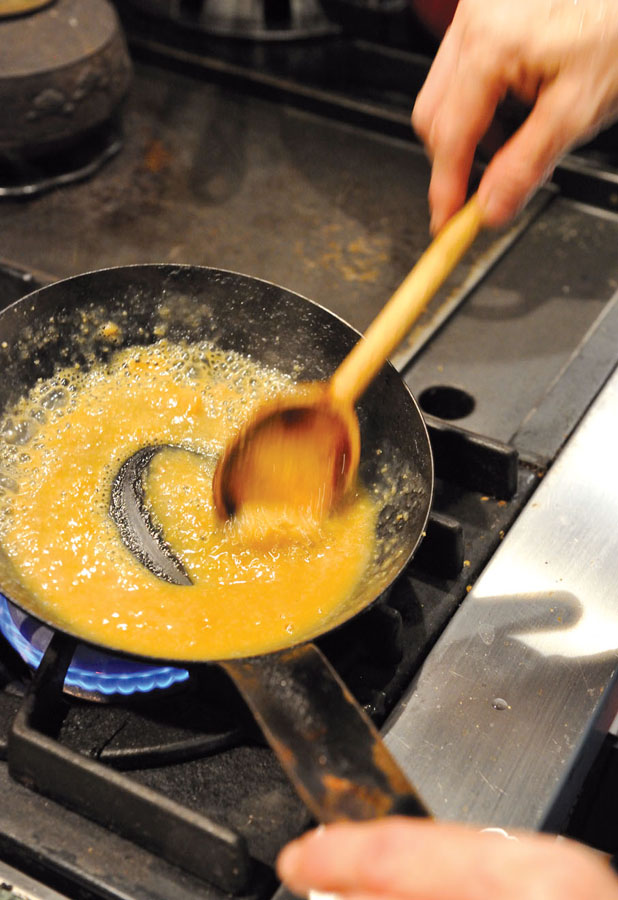
I had not eaten teriyaki anything since the Tiki Room at Disneyland until we had teriyaki burgers at a television shoot staged at our friend Matsuda-san’s place. We don’t add much sugar to our food, so for me it made sense to make teriyaki sauce by reducing Tadaaki’s country version of teriyaki marinade. It worked. This sauce keeps indefinitely but will intensify in the fridge, so be careful not to use too much and overflavor when adding to ground meat.
teriyaki sauce MAKES 1 CUP (250 CC)
TERIYAKI SOSU
1 cup (250 cc) mirin
1 cup (250 cc) soy sauce
1 (1-inch/2.5-cm) square piece of ginger, peeled and grated
Simmer the mirin, soy sauce, and ginger in a small saucepan over medium heat and reduce by about half. Cool. Add to ground meats to give teriyaki flavor. (Dry meats such as chicken or pork will benefit from equal parts fresh bread crumbs and eggs to help keep them moist.)
Inspired by the teriyaki burger photo shoot for Dochi no Ryori Show up at Matsuda-san’s place, Tadaaki marinated some chicken one day and served it teriyaki style that night. I was pleasantly surprised by the gentle teriyaki flavor that was neither too sweet nor too overpoweringly seasoned.
teriyaki marinade MAKES 1 CUP (250 CC)
TERIYAKI MARINEI
½ cup (125 cc) mirin
½ cup (125 cc) soy sauce
1 (2 by 1-inch/5 by 2.5-cm) piece of ginger, peeled and grated
Mix the mirin, soy sauce, and grated ginger in a small bowl or measuring cup. Use as a marinade for chicken or pork chops. There should be enough marinade so that it covers all the surfaces of the meat but the meat does not need to be swimming in it. Massage the teriyaki marinade gently into the meat to distribute. Refrigerate the marinating meat for half a day or overnight (up to 2 days—though be aware that the flavor will intensify as each day passes). Discard any extra marinade after you remove the meat.
Mitarashi sauce is almost like a glaze, though a bit thicker. I prefer my dango a tad more austere, with just the taste of charcoal-caramelized soy sauce. But if you like a sweeter flavor, by all means dunk the dango balls in mitarashi sauce after cooking.
sweet soy-flavored sauce MAKES ⅔ CUP (150CC)
MITARASHI SOSU
8 tablespoons soy sauce
1 tablespoon potato starch (katakuriko)
4 tablespoons organic sugar
In a small bowl, whisk the soy sauce into the potato starch and pour into a small saucepan with the sugar. Stir to blend and bring to a simmer over medium-low heat, stirring occasionally to keep the sugar from sticking on the bottom. Simmer gently for 10 to 15 minutes until the bubbles are thick and the sauce is glossy. Remove from the heat. Keeps for several weeks in the refrigerator; warm before using.
RATIO: soy sauce : sugar : potato starch—8 : 4 : 1
Along with kinako (soybean powder), kuromitsu is one of the most commonly used components in Japanese sweets. One of the first sweets I encountered in Japan were single servings of kuzu mochi smothered in kinako powder set into little plastic trays with a tiny plastic squeeze bottle of kuromitsu for each mochi. I remember licking that tray clean each time I ate one. Kuromitsu reminds me of blackstrap molasses, so feel free to substitute. Kuromitsu is also good drizzled on vanilla ice cream or vanilla-flavored custard.
black sugar syrup MAKES 5 TABLESPOONS
KUROMITSU
8 tablespoons Japanese black sugar, lumps smashed
In a small saucepan, heat the black sugar with 4 tablespoons water over medium heat until large bubbles form. Decrease the heat to low, and simmer for about 1 or 2 minutes until slightly thickened. You should have 5 tablespoons, if you have more, cook a bit longer; if you have less, stir in a bit of water. Remove from the heat to cool. Keeps indefinitely in the fridge stored in a jar, but warm slightly to take the chill off before using.